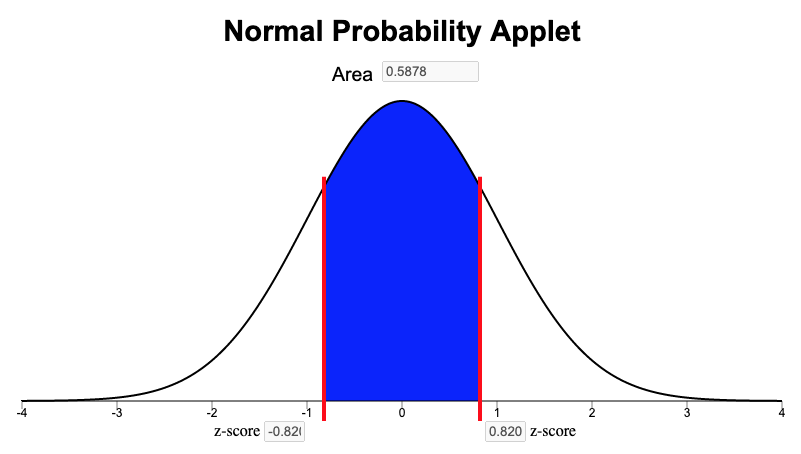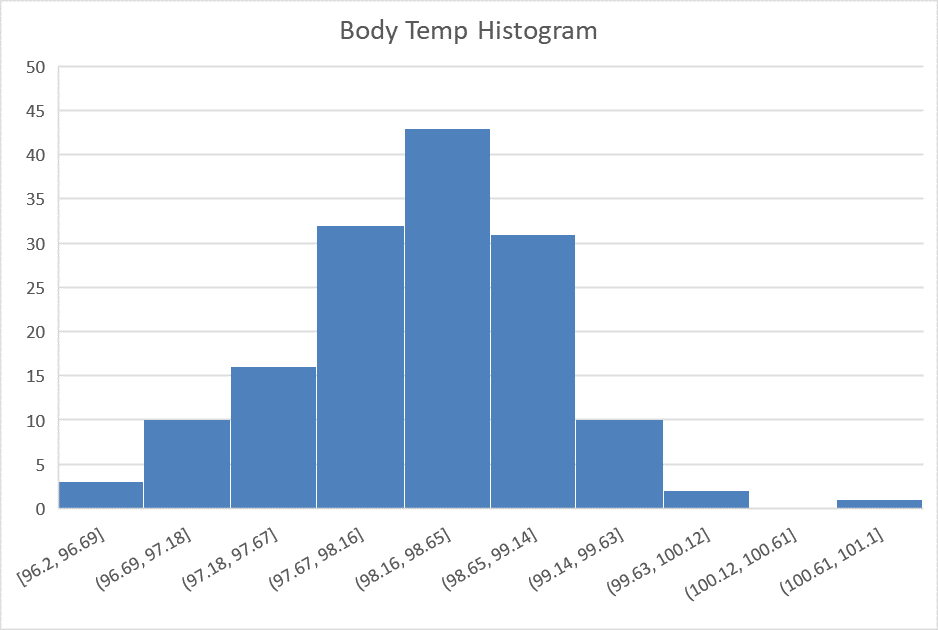Lesson 5: Normal Distributions
Optional Videos for this Lesson
Part 1
Part 2
Part 3
Lesson Outcomes
By the end of this lesson, you should be able to:
- State the properties of a normal distribution
- Calculate the z-score for an individual observation, given the population mean and standard deviation
- Interpret a z-score
- Use the normal distribution to calculate probabilities for one observation
- Approximate probabilities from a normal distribution using the 68-95-99.7 rule
- Calculate a percentile using the normal distribution
Normal Distributions and Normal Computations
Baseball Batting Averages

In baseball, a player called the “pitcher” throws a ball to a player called the “batter.” The batter swings a wooden or metal bat and tries to hit the ball. A “hit” is made when the batter successfully hits the ball and runs to a point in the field called first base. A player’s batting average is calculated as the ratio of the number of hits a player makes divided by the number of times the player has attempted to hit the ball or in other words, been “at bat.” Sean Lahman reported the batting averages of several professional baseball players in the United States. (Lahman, 2010) The file BattingAverages.xlsx contains his data.
The following histogram summarizes the batting averages for these professional baseball players:
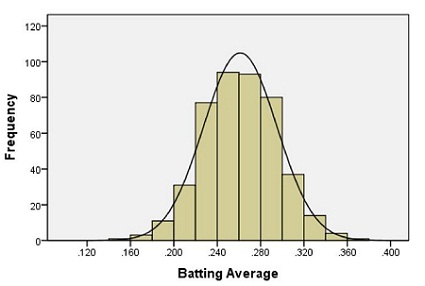
Notice the bell-shaped distribution of the data.
Suppose we want to estimate the probability that a randomly selected player will have a batting average that is greater than 0.280. One way to do this would be to find the proportion of players in the data set who have a batting average above 0.280. We can do this by finding the number of players who fall into each of the red-colored bins below and dividing this number by the total number of players.
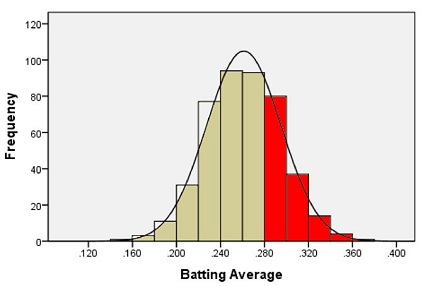
In other words, we could find the proportion of the total area of the bars that is shaded red out of the combined area of all the bars. This gives us the proportion of players whose batting averages are greater than 0.280.
Out of the 446 players listed, there are a total of 133 players with batting averages over 0.280. This suggests that the proportion of players whose batting average exceeds 0.280 is:
\[\displaystyle{\frac{133}{446}} = 0.298\]
Alternatively, we can use the fact that the data follow a bell-shaped distribution to find the probability that a player has a batting average above 0.280.
Density Curves
The bell-shaped curve superimposed on the histogram above is called a density curve. It is essentially a smooth histogram. Notice how closely this curve follows the observed data.
The density curve illustrated on the histogram of the batting average data is special. It is called a normal density curve. This density curve is symmetric and has a bell-shape.
The normal density curve is also referred to as a normal distribution or a “Gaussian” distribution (after Carl Friedrich Gauss.)
The normal density curve appears in many applications in business, nature, medicine, psychology, sociology, and more. We will use the normal density curve extensively in this course.
All density curves, including normal density curves, have two basic properties:
- The total area under the curve equals 1.
- The density curve always lies on or above the horizontal axis.
Because of these two properties, the area under the curve can be treated as a probability. If we want to find the probability that a randomly selected baseball player will have a batting average between some range of values, we only need to find the area under the curve in that range. This is illustrated by the region shaded in blue in the figure below.
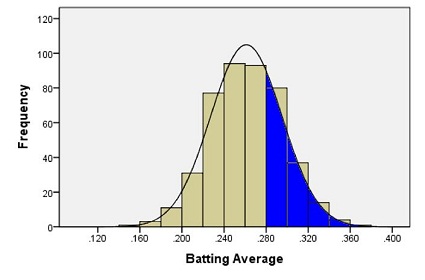
A normal density curve is uniquely determined by its mean, \(\mu\), and its standard deviation, \(\sigma\). So, if random variables follow a normal distribution with a known mean and standard deviation, then we can calculate any probabilities related to that variable by finding the area under the curve.
When the mean of a normal distribution is 0 and its standard deviation is 1, we call it the standard normal distribution.
We will return to this example later, and we will find the area shaded in blue.
Characteristics of the Normal Curve
Introduction to \(z\)-scores
In Ghana, the mean height of young adult women is normally distributed with mean \(159.0\) cm and standard deviation \(4.9\) cm. (Monden & Smits, 2009) Serwa, a female BYU-Idaho student from Ghana, is \(169.0\) cm tall. Her height is \(169.0 - 159.0 = 10\) cm greater than the mean. When compared to the standard deviation, she is about two standard deviations (\(\approx 2 \times 4.9\) cm) taller than the mean.
The heights of men are also normally distributed. The mean height of young adult men in Brazil is \(173.0\) cm (“Oramento,” 2010), and the standard deviation for the population is \(6.3\) cm. (Castilho & Lahr, 2001) A Brazilian BYU-Idaho student, Gustavo, is \(182.5\) cm tall. Compared to other Brazilians, he is taller than the mean height of Brazilian men.
Computing \(z\)-scores
When we examined the heights of Serwa and Gustavo, we compared their height to the standard deviation. If we look carefully at the steps we did, we subtracted the mean height for people of the same gender and nationality from each individual’s height, respectively.
This shows how much taller or shorter the person is than the mean height. In order to compare the height difference to the standard deviation, we divide the difference by the standard deviation. This gives the number of standard deviations the individual is above or below the mean.
For example, Serwa’s height is 169.0 cm. If we subtract the mean and divide by the standard deviation, we get \[z = \frac{169.0 - 159.0}{4.9} = 2.041\] We call this number a \(z\)-score. The \(z\)-score for a data value tells how many standard deviations away from the mean the observation lies. If the \(z\)-score is positive, then the observed value lies above the mean. A negative \(z\)-score implies that the value was below the mean.
We compute the \(z\)-score for Gustavo’s height similarly, and obtain \[z = \frac{182.5 - 173.0}{6.3} = 1.508\] Gustavo’s \(z\)-score is 1.508. As noted above, this is about one-and-a-half standard deviations above the mean. In general, if an observation \(x\) is taken from a random process with mean \(\mu\) and standard deviation \(\sigma\), then the \(z\)-score is \[z = \frac{x -\mu }{\sigma}\]
The \(z\)-score can be computed for data from any distribution, but it is most commonly applied to normally distributed data.
68-95-99.7% Rule for Bell-shaped Distributions
Heights of women (or men) in a particular population follow a normal distribution. Most people’s heights are close to the mean. A few are very tall or very short. We would like to make a more precise statement than this.
For any bell-shaped distribution, - 68% of the data will lie within 1 standard deviation of the mean, - 95% of the data will lie within 2 standard deviations of the mean, and - 99.7% of the data will lie within 3 standard deviations of the mean.
This is called the 68-95-99.7% Rule for Bell-shaped Distributions.
Some statistics books refer to this as the Empirical Rule.
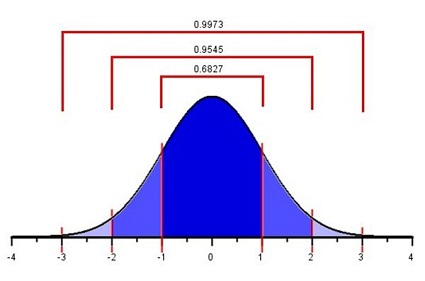
Approximately 68% of the observations from a bell-shaped distribution will be between the values of \(\mu -~\sigma~\)and \(\mu +~\sigma\). Consider the heights of young adult women in Ghana. We expect that about 68% of Ghanaian women have a height between the values of \[\mu -~\sigma = 159.0 - 4.9 = 154.1~\text{cm}\] and \[\mu +~\sigma = 159.0 + 4.9 = 163.9~\text{cm}.\]
So, if a female is chosen at random from all the young adult women in Ghana, about 68% of those chosen will have a height between 154.1 and 163.9 cm. Similarly, 95% of the women’s heights will be between the values of \[\mu - 2\sigma = 159.0 - 2(4.9) = 149.2~\text{cm}\] and \[\mu + 2\sigma = 159.0 + 2(4.9) = 168.8~\text{cm}.\]
Finally, 99.7% of the women’s heights will be between \[\mu - 3\sigma = 159.0 - 3(4.9) = 144.3~\text{cm}\] and \[\mu + 3\sigma = 159.0 + 3(4.9) = 173.7~\text{cm}.\]
Unusual Events
If a \(z\)-score is extreme (either a large positive number or a large negative number), then that suggests that that observed value is very far from the mean. The 68-95-99.7% rule states that 95% of the observed data values will be within two standard deviations of the mean. This means that 5% of the observations will be more than 2 standard deviations away from the mean (either to the left or to the right).
We define an unusual observation to be something that happens less than 5% of the time. For normally distributed data, we determine if an observation is unusual based on its \(z\)-score. We call an observation unusual if \(z < -2\) or if \(z > 2\). In other words, we will call an event unusual if the absolute value of its \(z\)-score is greater than 2.
- Out of Serwa and Gustavo, who is physically taller?
- Relative to their own gender and nationality, who is relatively taller?
- Are either of these heights unusual?

Normal Probability Computations
An important part of the practice of statistics is finding areas under a normal curve. The area under a normal curve, say, to the left of a value, gives the probability of obtaining an observation less than (or equal to) that value. This is an example of converting a value to an area. It is also important to convert an area to a value. For example, if you want to find the 40th percentile for data that follow a normal distribution, you find the value of the observation such that the area (under the curve) to the left of this value is 0.40.
Introduction to the Normal Probability Applet
The Normal Probability Applet is a visualization program offering statistics students insights and computations for the relationship between \(z\)-scores and areas under the standard normal curve. You can find a link to this applet on I-learn, under the Course Resources module. This app is also compatible to use on your phone, iPad, and other mobile devices. The app is stored at https://byuimath.com/apps/normprob.html. If you want a copy you can open from your desktop, just right click the link and save it to your computer.
To use this applet, follow these instructions:
Click on an area below the curved line to shade/unshade the region. Click and drag the red lines to adjust the \(z\)-scores and obtain the area. Type a \(z\)-score into one of the bottom input boxes and hit “Enter” to get an area. Type in an area and hit “Enter” to get a \(z\)-score.
Converting a \(z\)-score to a Probability
Using this applet we can calculate proportions and probabilities based on the area under the normal curve. For the following examples, please open the Normal Probability Applet and practice using it to find areas under the curve.
Heights of Ghanaian Women
We will use the example of Serwa’s height to find the proportion of young Ghanaian women who are shorter than Serwa. Recall that for the height of young Ghanaian women, the population mean is 159.0 cm and the population standard deviation is 4.9 cm. Serwa’s height is 169.0 cm. We found the \(z\)-score of Serwa’s height as:
\[z = \frac{x -\mu}{\sigma} = \frac{169.0- 159.0}{4.9} = 2.041\]
What proportion of young Ghanaian women reach a height that is at or below 169 cm? To answer this question, we need to find the area under a normal density curve (i.e. the probability) that is to the left of \(z = 2.041\).
To find the area under a normal curve corresponding to a \(z\)-score of \(2.041\), do the following:
- Type the \(z\)-score of \(2.041\) into one of the two boxes along the horizontal axis of the graph.
- Click on the areas under the curve until only the areas left of the \(z\)-score are shaded blue.
- The total shaded area under the normal distribution, 0.979*, is given above the graph. This is the proportion of young Ghanaian women who are shorter than Serwa.
The area to the left of our chosen \(z\)-score is also the probability that a randomly selected woman will be shorter than Serwa. The probability that a randomly selected Ghanaian woman will be shorter than Serwa is \(0.979\), or \(97.9\%\).
Baseball Averages
We now return to the example of the baseball batting averages. We want to find the probability that a randomly selected player will have a batting average that is above 0.280. The population mean is 0.261 and the population standard deviation is 0.034. We can use this information to find a \(z\)-score. Then we use the applet to find the area under the normal curve to the right of this \(z\)-score.
\[z = \frac{x -\mu}{\sigma} = \frac{0.280 - 0.261}{0.034} = 0.559\]
Type the \(z\)-score of \(0.559\) in one of the boxes below the horizontal axis in the applet. Click on the areas under the curve until only the region on the right is highlighted in blue.
The area under the curve to the right of \(z = 0.559\) is \(0.288\). This is the probability that a randomly selected player will have a batting average that is greater than 0.280. (Note: It is a coincidence that the area, 0.288, is close to the batting average of 0.280. There is no significance in this.)
Notice that the area shaded in blue above 0.288 is very close to the area we found when we looked at the area represented by the bars of the histogram 0.298 that was shaded in red above.
Finding the Probability of Being Between Two Values
The normal probability applet allows us to find the probability of being between two values as long as they are on opposite sides of the mean and equally distanced from the mean. By calculating two z-scores, one for each value, and then shading the area between them on the applet, we can find the probability.
Heights of Ghanaian Women
We illustrate the procedure for finding the probability that the height of a randomly selected young Ghanaian woman is between two values. For example, “What is the probability that a randomly selected young Ghanaian women will be between 155.0 cm and 163.0 cm tall?” Recall that for the height of young Ghanaian women, the population mean is \(\mu=159.0\) cm and the population standard deviation is \(\sigma=4.9\) cm. We want to find the probability that a randomly selected woman’s height is between \(155.0\) cm and \(163.0\) cm. To do this we find the \(z\)-score for both values:
\[z_1 = \frac{x- \mu}{\sigma} = \frac{155.0 - 159.0}{4.9} = -0.82\] \[z_2 = \frac{x - \mu}{\sigma} = \frac{163.0 -159.0}{4.9} = 0.82\]
Notice that both z-scores give the same value, just one is positive and one is negative. Had the two values given different z-scores, we would have to take a more complicated approach to finding the area between them. (See the link below if you are interested, but this is bonus knowledge, and is not required for the course.)
We now answer the question by finding the area under the normal density curve (i.e. the probability) between the z-scores of \(z=-0.82\) and \(z=0.82\). To find the area between \(z = -0.82\) and \(z = 0.82\), we simply type in our z-scores (or just one of them is all you need) and shade the middle area:
So the probability that the height of a randomly selected young Ghanaian woman will be between 155.0 cm and 163.0 cm is 0.5878. We found this answer from the “Area” box in the Normal Probability Applet as shown above. Another way to word this is to say that the proportion of all young Ghanaian women who are between 155.0 and 163.0 cm tall is \(0.5878\), or that 58.78% of Ghanaian women are between 1550. and 163.0 cm tall.
Calculating Percentiles using a Normal Distribution
A percentile is a number such that a specified percentage of the data are at or below this number. For example, the 25th percentile is the number in a data set that is greater than or equal to 25% of all the values in the data set. (For a more complete definition of percentiles, see Lesson 3.) We can find the values of percentiles for a normal distribution by using the applet to calculate the \(z\)-score corresponding to a specified area and then plugging that \(z\)-score into our \(z\)-score equation and solving for \(x\). The following instructions show how to find the 90th percentile of the distribution of batting averages.
First, we need to find the \(z\)-score that corresponds to the 90th percentile using the Normal Probability Applet.
- Click on the areas under the curve until only the areas left of the positive \(z\)-score are shaded blue.
- Type the desired area (or percentile) in the box at the top of the graph. (Type in a number between 0 and 1. A 90th percentile would be entered as “0.900”.)
- The \(z\)-score corresponding to this area will be displayed in the bottom right box.
For example, to find the \(z\)-score
corresponding to the 90th percentile, click on the regions of
the graph so that the area to the left of one of the bars is shaded and
nothing is shaded to the right. Then, type the number 0.9 in the box at
the top of the applet and press Enter. The value 1.282 is
the \(z\)-score such that 90% of the
area is to the left.
So, \(z = 1.282\) is the \(z\)-score that corresponds to the 90th percentile of a normal distribution. How do we find the batting average that corresponds to the 90th percentile? We can solve for \(x\) in the equation for the \(z\)-score.
\[\displaystyle{z=\frac{x - \mu}{\sigma}}\]
We know \(z = 1.282\), \(\mu = 0.261\), and \(\sigma = 0.034\). Substituting these values into the equation for the \(z\)-score, we have:
\[1.282 = \frac{x -0.261}{0.034 }\]
Solve for \(x\):
| Original Equation | \(\displaystyle{ 1.282 }\space\) | \(=\) | \(\displaystyle{ \frac{x - 0.261}{0.034 }}\) |
| \(~\) | |||
| Multiply both sides by 0.034 | \(\displaystyle{ 1.282 (0.034) }\space\) | \(=\) | \(\displaystyle{ \frac{x -0.261}{0.034 } \cdot (0.034) }\) |
| \(~\) | |||
| Simplify the right-hand side | \(\displaystyle{ 1.282 (0.034) }\space\) | \(=\) | \(\displaystyle{ x - 0.261 }\) |
| \(~\) | |||
| Add 0.261 to both sides | \(\displaystyle{ 0.261 + 1.282(0.034)}\space\) | \(=\) | \(\displaystyle{ 0.261 + (x - 0.261) }\) |
| \(~\) | |||
| Simplify the right-hand side | \(\displaystyle{ 0.261 + 1.282(0.034)}\space\) | \(=\) | \(\displaystyle{ x }\) |
| \(~\) | |||
| Simplify the left-hand side | \(\displaystyle{ 0.305 }\space\) | \(=\) | \(\displaystyle{ x }\) |
| \(~\) | |||
| Swap the left- and right-hand sides | \(\displaystyle{ x }\space\) | \(=\) | \(\displaystyle{ 0.305 }\) |
The 90th percentile of the batting averages is 0.305. That means that 90% of the players have a batting average that is 0.305 or less.
The ability to use the Normal Probability Applet to find probabilities is very important in this course. Take some time to familiarize yourself with the applet and to practice using it.
Assessing Normality Using a Histogram
Baseball Batting Averages
Recall the data on the batting averages of Major League Baseball players. The histogram of the batting averages showed a distinct bell-shaped curve.

Here is a refresher of how to make a Histogram in Excel
For more detailed instructions revisit Lesson 3.
- Highlight the data you want to summarize with a histogram
- Go to the Insert ribbon in Excel and select the histogram icon from the “Charts” section of the ribbon. Then select the first option of histograms presented.
The Excel default histogram for this dataset is pretty good. However, if your dataset is relatively small, skewed, or outliers are present, experimenting with different bin sizes can help you get a better idea of the shape of the distribution.
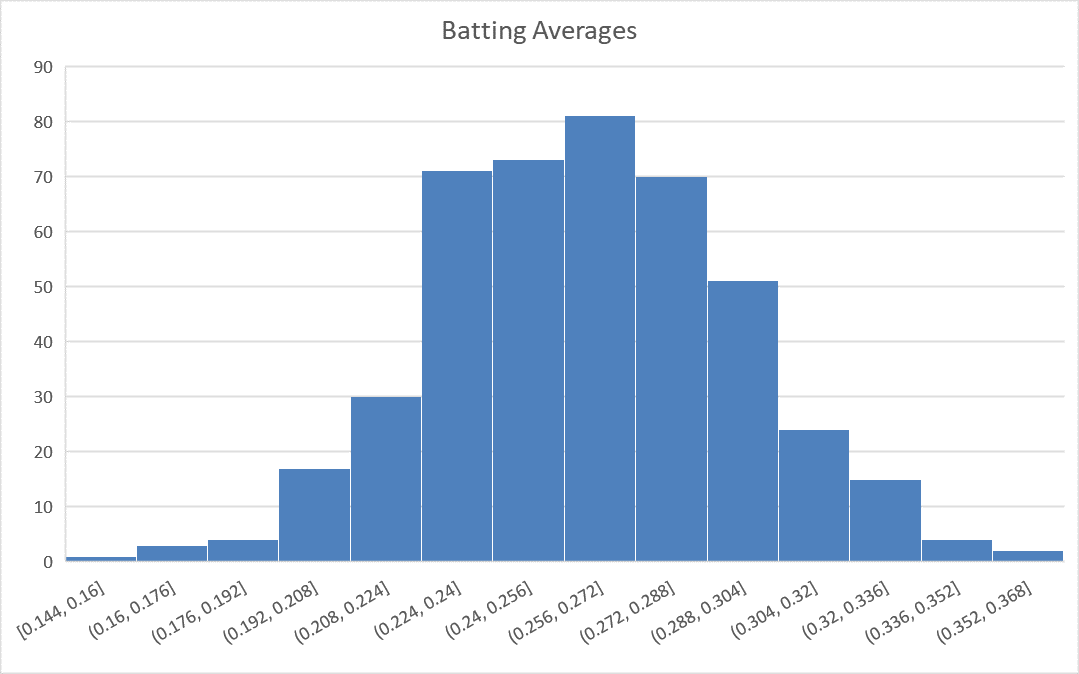
Optional: You can explore the shape of the distribution of data by adjusting the number of bins on the histogram with these steps:
Be sure the graph is selected, so that you can select the “Format” ribbon. In the upper left corner of the ribbon, select “Horizontal Category Axis” in the drop-down box. Then click on “Format Selection”.
- On many computers, a quicker method to access the same menu is to right click anywhere on the x-axis and select “Format Axis”.
A menu of options will open on the right side of the screen. You can adjust the bin width or number of bins. Experiment with a few different values to see if the histogram changes much in shape.
Body Temperatures
A group of researchers led by Philip A. Mackowiak, MD, conducted a study to assess the true mean body temperatures of healthy adults. They selected n = 148 subjects between the ages of 18 and 40 years old, representative of the general population.
Each volunteer was given a physical to assure that they were not ill at the time of the data collection. Their axillary (under the arm) body temperature was measured and reported in a paper published in the Journal of the American Medical Association. [1] These data were extracted and are presented in the file BodyTemp. The body temperatures are given in degrees Fahrenheit.
- Make a histogram of the body temperature data.
- Based on your histogram, what is the shape of the distribution of these data?
- Calculate the following numerical summaries of the data: sample mean, sample standard deviation, and sample size.
Wages of BYU-Idaho Students
The Survey Data file contains data on hourly wages of BYU-Idaho students. Use that data to answer the following questions.
- Make a histogram of the data contained in the Wage column. Note: there are gaps in the dataset, be sure you highlight all the way down to the last value in that column
- Based on your histogram, what is the shape of the distribution of these data?
Summary
A normal density curve is symmetric and bell-shaped with a mean of \(\mu\) and a standard deviation of \(\sigma\). The curve lies above the horizontal axis and the total area under the curve is equal to 1. A standard normal distribution has a mean of 0 and a standard deviation of 1.
A z-score is calculated as: \(\displaystyle{z = \frac{\text{value}-\text{mean}}{\text{standard deviation}} = \frac{x-\mu}{\sigma}}\)
A z-score tells us how many standard deviations above (\(+Z\)) or below (\(-Z\)) the mean (\(\mu\)) a given value (\(x\)) is.
To calculate probabilities for an observation \(x\), calculate the \(z\)-score using \(\mu\), \(\sigma\), and \(x\) and then use the Normal Probability Applet to shade the appropriate area of the distribution for the desired probability. The area shaded depends on both the direction of interest (above, below, between) and the sign of the z-score as depicted in the images below. In every case, the probability is given by the Area box at the top of the applet.
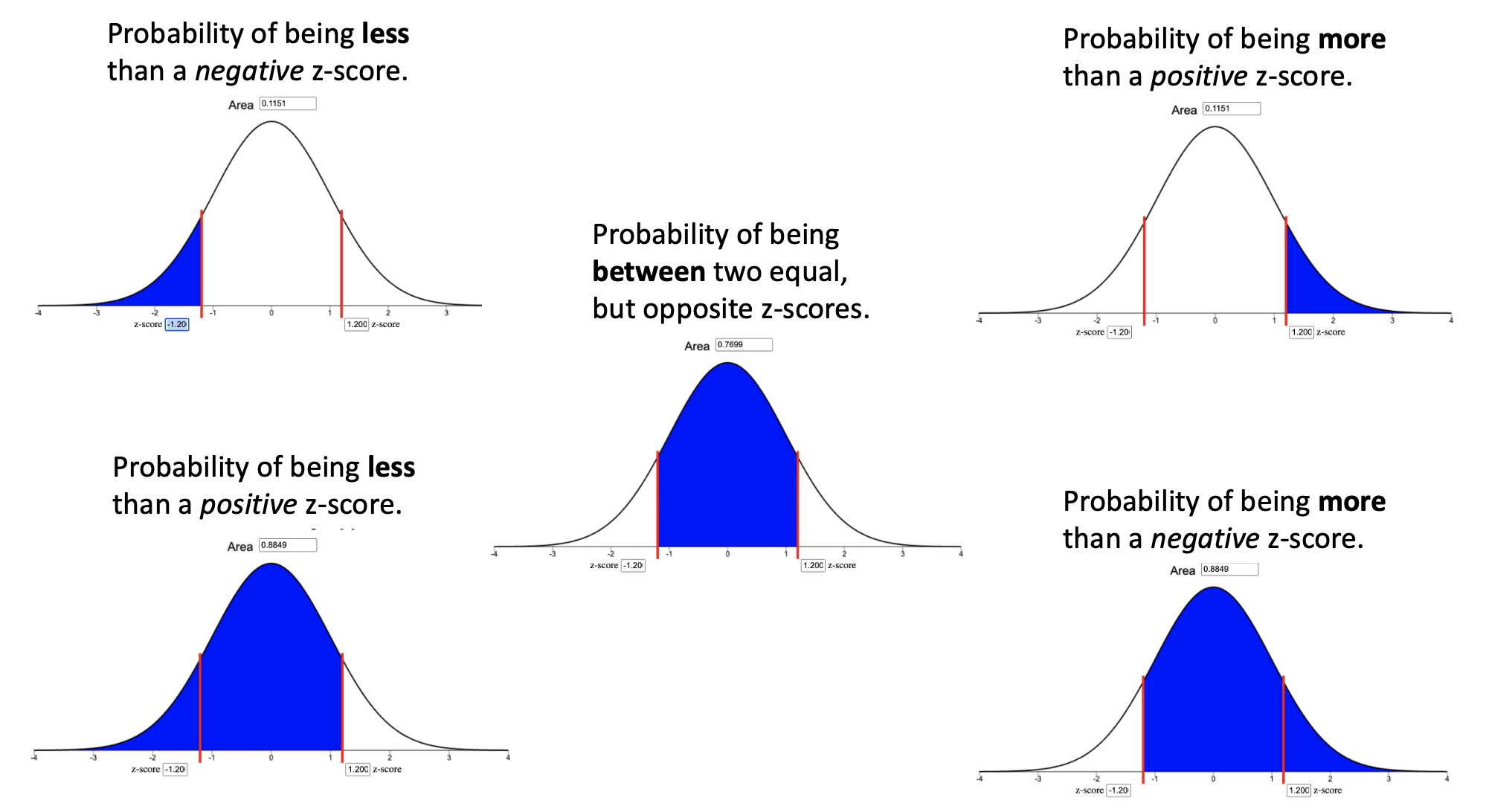
The 68-95-99.7% rule states that when data are normally distributed, approximately 68% of the data lie within \(z=1\) standard deviation (\(\sigma\)) from the mean, approximately 95% of the data lie within \(z=2\) standard deviations from the mean, and approximately 99.7% of the data lie within \(z=3\) standard deviations from the mean. For example, this rule approximates that 2.5% of observations will be less than a z-score of \(z=-2\).
Percentiles can be calculated using the Normal Probability Applet by (1) shading the left tail only, (2) entering the desired percentile in the “Area” box, and (3) using the z-score from where the blue shaded region ends solve for \(x\) in the equation \(z=\frac{x-\mu}{\sigma}\).
Alumni Spotlight: Adam Andersen

Statistics have been useful in multiple aspects of my work in Human Resources and Diversity. I created a dynamic spreadsheet model for analyzing workforce salaries, both company-wide and for discrete job functions within various levels of the organization. This model utilizes averages and sets thresholds that trigger flags for anomalies in proposed salary offer decisions, including those beyond two standard deviations of the internal peer average. These flags prompt review, discussion, and provide opportunities to vet offer decisions and to substantiate and document the basis for any outlier salary decisions. This has proved to promote and maintain salary equity among women and minorities and their majority peers.
I also use statistics in developing metrics for our management team to assess the human-capital health of the organization. With the looming retirement of the baby-boomer bubble, I analyzed the distribution of our current workforce by age. Further, I broke out a subset of mission critical disciplines and compared it to the entire workforce. This allowed a view into where we were, at least in terms of headcount, in developing a human capital pipeline to backfill these areas. I then compared this to the weighted average historical percentage of retirements by age, all things equal, to predict approximately what percent of the current workforce, including these mission critical disciplines, would retire and by when. This data has been presented to our management council, the corporate office, and will be utilized at an upcoming leadership strategy session.
Despite having studied statistics at BYU-Idaho several years ago (in fact, I nearly took the course twice), I have felt the Holy Ghost bring these basic concepts to my remembrance and teach me how to apply them at work. And for that, I am grateful.
Biography:
Adam D. Andersen is the Human Capital Management
System Lead for Battelle Energy Alliance, LLC at the U.S. Department of
Energy’s Idaho National Laboratory in Idaho Falls, Idaho. He is
responsible for creating and revising employment policies and
procedures; coordinating human capital assurance; leading measurement
and reporting; managing contract and regulatory requirements; and
assisting in-house legal counsel in employee disciplinary advisory
groups and in representing the company in disputes involving its five
labor unions.
Adam has served as a full-time missionary for The
Church of Jesus Christ of Latter-Day Saints in the Philippines Tacloban
Mission, twice as a counselor in Elders Quorum Presidencies, as a leader
in the Cub and Boy Scouts, and as a counselor in a student-ward
Bishopric at BYU-Idaho. He currently serves as a counselor in the
Bishopric in his home ward in Idaho Falls, Idaho.
Adam holds a
Bachelor of Science in Accounting, Cum Laude, from BYU-Idaho, a Juris
Doctor, Honors, from Washburn University School of Law, and is admitted
to practice law in the state of Idaho. He is married to Katarzyna
Zamarlik of Bielsko-Biala, Poland. They have three children, Spencer,
Lea, and Scott.
References
Castilho, L. V., & Lahr, M. M. (2001). Secular trends in growth among urban Brazilian children of European descent. Human Biology, 28, 564.
Lahman, S.Sean lahman’s baseball archive. Retrieved November, 2010, from http://www.baseball1.com/
Monden, C. W. S., & Smits, J. (2009). Maternal height and child mortality in 42 developing countries. American Journal of Human Biology, 21(3), 305.
Or?amento e Gest?o Minist?rio do Planejamento. Pesquisa de or?amentos familiars 2008-2009: Antropometria e estado nutricional de crian?as, adolescentes e adultos no brasil. Technical report, Instituto Brasileiro de Geografi a e Estat?stica - IBGE, Rio de Janeiro, Brazil 2010.
Copyright © 2020 Brigham Young University-Idaho. All rights reserved.
